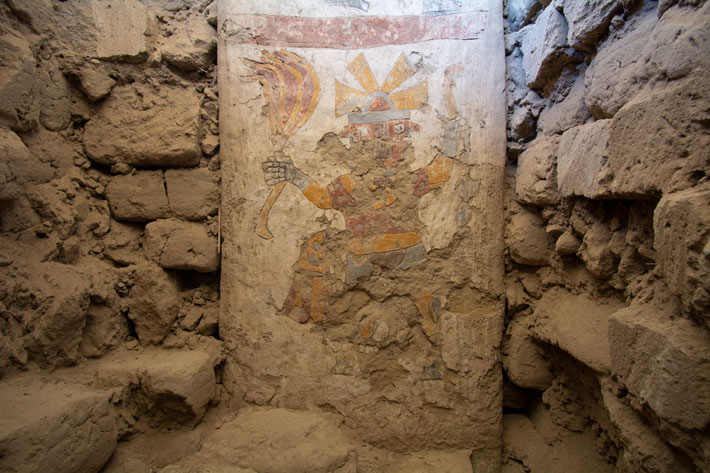 LIMA, PERU—According to a Live Science report, two 1,400-year-old paintings discovered this past summer in coastal Peru at the Moche site of Pañamarca contain images that may reflect artists’ experimentation with depicting movement. The murals were both placed on a pillar in a heavily painted hall where murals were first discovered in 1958. The first painting, near the top of the pillar, shows a man with two faces looking in opposite directions. He holds a fan with moving feathers in one hand and four hummingbirds drinking from a goblet in the other. Lower on the same pillar, a second man with two faces holds a feather fan in one hand and a partially preserved stick-like object in the other. Both men are wearing a crown or headdress, colorful clothing, and belts. Lisa Trever of Columbia University thinks the men may be deities, and that the images could depict two narrative moments. “Typically, deity images in Moche art have non-human aspects like fangs, or the faces or tails or wings of various creatures,” she said. “This one, with the exception of the two faces, seems entirely human.” For more on the murals at Pañamarca, go to "Painted Worlds."
LIMA, PERU—According to a Live Science report, two 1,400-year-old paintings discovered this past summer in coastal Peru at the Moche site of Pañamarca contain images that may reflect artists’ experimentation with depicting movement. The murals were both placed on a pillar in a heavily painted hall where murals were first discovered in 1958. The first painting, near the top of the pillar, shows a man with two faces looking in opposite directions. He holds a fan with moving feathers in one hand and four hummingbirds drinking from a goblet in the other. Lower on the same pillar, a second man with two faces holds a feather fan in one hand and a partially preserved stick-like object in the other. Both men are wearing a crown or headdress, colorful clothing, and belts. Lisa Trever of Columbia University thinks the men may be deities, and that the images could depict two narrative moments. “Typically, deity images in Moche art have non-human aspects like fangs, or the faces or tails or wings of various creatures,” she said. “This one, with the exception of the two faces, seems entirely human.” For more on the murals at Pañamarca, go to "Painted Worlds."
Moche Murals Uncovered in Peru
